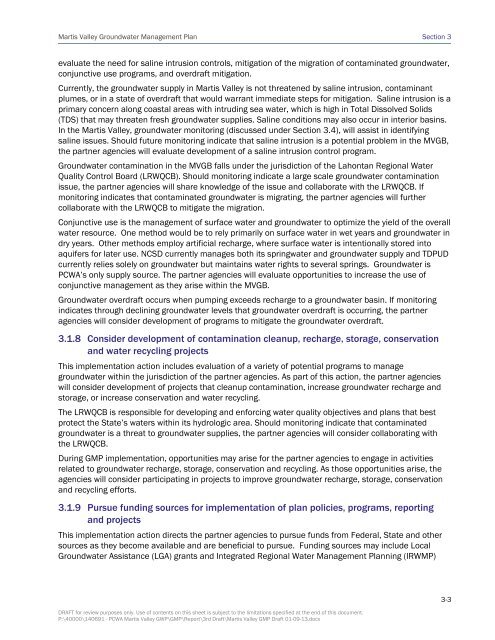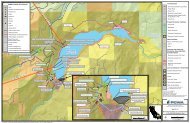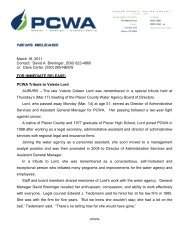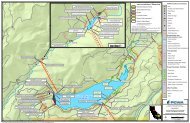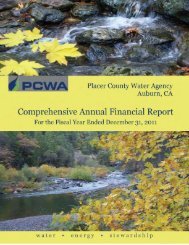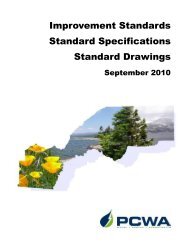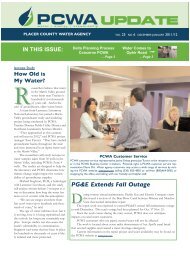Martis Valley Groundwater Management Plan - Placer County Water ...
Martis Valley Groundwater Management Plan - Placer County Water ...
Martis Valley Groundwater Management Plan - Placer County Water ...
You also want an ePaper? Increase the reach of your titles
YUMPU automatically turns print PDFs into web optimized ePapers that Google loves.
<strong>Martis</strong> <strong>Valley</strong> <strong>Groundwater</strong> <strong>Management</strong> <strong>Plan</strong> Section 3<br />
evaluate the need for saline intrusion controls, mitigation of the migration of contaminated groundwater,<br />
conjunctive use programs, and overdraft mitigation.<br />
Currently, the groundwater supply in <strong>Martis</strong> <strong>Valley</strong> is not threatened by saline intrusion, contaminant<br />
plumes, or in a state of overdraft that would warrant immediate steps for mitigation. Saline intrusion is a<br />
primary concern along coastal areas with intruding sea water, which is high in Total Dissolved Solids<br />
(TDS) that may threaten fresh groundwater supplies. Saline conditions may also occur in interior basins.<br />
In the <strong>Martis</strong> <strong>Valley</strong>, groundwater monitoring (discussed under Section 3.4), will assist in identifying<br />
saline issues. Should future monitoring indicate that saline intrusion is a potential problem in the MVGB,<br />
the partner agencies will evaluate development of a saline intrusion control program.<br />
<strong>Groundwater</strong> contamination in the MVGB falls under the jurisdiction of the Lahontan Regional <strong>Water</strong><br />
Quality Control Board (LRWQCB). Should monitoring indicate a large scale groundwater contamination<br />
issue, the partner agencies will share knowledge of the issue and collaborate with the LRWQCB. If<br />
monitoring indicates that contaminated groundwater is migrating, the partner agencies will further<br />
collaborate with the LRWQCB to mitigate the migration.<br />
Conjunctive use is the management of surface water and groundwater to optimize the yield of the overall<br />
water resource. One method would be to rely primarily on surface water in wet years and groundwater in<br />
dry years. Other methods employ artificial recharge, where surface water is intentionally stored into<br />
aquifers for later use. NCSD currently manages both its springwater and groundwater supply and TDPUD<br />
currently relies solely on groundwater but maintains water rights to several springs. <strong>Groundwater</strong> is<br />
PCWA’s only supply source. The partner agencies will evaluate opportunities to increase the use of<br />
conjunctive management as they arise within the MVGB.<br />
<strong>Groundwater</strong> overdraft occurs when pumping exceeds recharge to a groundwater basin. If monitoring<br />
indicates through declining groundwater levels that groundwater overdraft is occurring, the partner<br />
agencies will consider development of programs to mitigate the groundwater overdraft.<br />
3.1.8 Consider development of contamination cleanup, recharge, storage, conservation<br />
and water recycling projects<br />
This implementation action includes evaluation of a variety of potential programs to manage<br />
groundwater within the jurisdiction of the partner agencies. As part of this action, the partner agencies<br />
will consider development of projects that cleanup contamination, increase groundwater recharge and<br />
storage, or increase conservation and water recycling.<br />
The LRWQCB is responsible for developing and enforcing water quality objectives and plans that best<br />
protect the State’s waters within its hydrologic area. Should monitoring indicate that contaminated<br />
groundwater is a threat to groundwater supplies, the partner agencies will consider collaborating with<br />
the LRWQCB.<br />
During GMP implementation, opportunities may arise for the partner agencies to engage in activities<br />
related to groundwater recharge, storage, conservation and recycling. As those opportunities arise, the<br />
agencies will consider participating in projects to improve groundwater recharge, storage, conservation<br />
and recycling efforts.<br />
3.1.9 Pursue funding sources for implementation of plan policies, programs, reporting<br />
and projects<br />
This implementation action directs the partner agencies to pursue funds from Federal, State and other<br />
sources as they become available and are beneficial to pursue. Funding sources may include Local<br />
<strong>Groundwater</strong> Assistance (LGA) grants and Integrated Regional <strong>Water</strong> <strong>Management</strong> <strong>Plan</strong>ning (IRWMP)<br />
DRAFT for review purposes only. Use of contents on this sheet is subject to the limitations specified at the end of this document.<br />
P:\40000\140691 - PCWA <strong>Martis</strong> <strong>Valley</strong> GWP\GMP\Report\3rd Draft\<strong>Martis</strong> <strong>Valley</strong> GMP Draft 01-09-13.docx<br />
3-3


